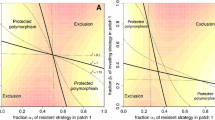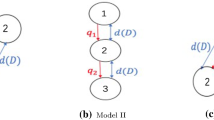Summary
Many models have been proposed in which environmental heterogeneity promotes genetic diversity. Such models describe the situation where different phenotypes have different fitness values in different types of patch and are the genetic equivalent of the traditional resource partitioning models in ecology which allow the coexistence of species. Here we construct a different type of cellular model in which polymorphisms in populations ofDrosophila can be maintained without traditional resource partitioning. Parameter values taken from laboratory and field observations represent fungal breedingDrosophila. Some stochasticity is used in the description of the migration between patches. In the model space is divided into a uniform matrix of cells each of which has the potential to contain an ephemeral resource item (fungal fruiting body). Square arenas of up to 400 cells were used. Genotypes arrive at a fresh site, breed (Hardy-Weinberg equilibrium) and lay eggs. The eggs hatch and the larvae compete using the Hassell-Comins competition equations, as if they were three different species. Adult emergents all migrate to an adjacent cell. The aggregation patterns observed in nature are produced using an ‘attraction probability’ where each fly has a chance of moving to the currently most densely populated adjacent patch. This ‘black box’ description of migration produces distribution patterns which are indistinguishable from those seen in wild populations of fungal breedingDrosophila. Results show that the ‘attraction probability’ is the key factor in the maintenance of polymorphism and that even when the competitive advantage of the superior genotype is very great, polymorphisms can be maintained.
Similar content being viewed by others
References
Abrams, P. (1983) The theory of limiting similarity.Ann. Rev. Ecol. Syst. 14, 359–76.
Atkinson, W. D. and Shorrocks, B. (1981) Competition on a divided and ephemeral resource: a simulation model.J. Anim. Ecol. 50, 461–71.
Bellows, T. S. (1981) The descriptive properties of some models for density dependence.J. Anim. Ecol. 50, 139–56.
Bulmer, M. G. (1972) Multiple niche polymorphism.Am. Nat. 106, 254–7.
Christianson, F. B. (1974) Sufficient conditions for protected polymorphism in a subdivided population.Am. Nat. 108, 157–66.
Christianson, F. B. (1975) Hard and soft selection in a subdivided population.Am. Nat. 109, 11–16.
Clarke, B. (1973a) The effect of mutation on population size.Nature 242, 196–7.
Clarke, B. (1973b) Mutation and population size.Heredity 31, 367–79.
Cooper, R. (1990) Competition and genetic variation in a patchy environment: a laboratory model. PhD Thesis, Leeds University.
Gilpin, M. E. and Ayala, F. J. (1973) Global models of growth and competition.Proc. Natn. Acad. Sci. 70, 3590–3.
Hanski, I. (1981) Coexistence of competitors in patchy environments with and without predation.Oikos 37, 306–12.
Hassell, M. P. (1975) Density dependence in single species populations.J. Anim. Ecol. 42, 693–726.
Hassell, M. P. and Comins, H. N. (1976) Discrete time models for two-species competition.Theoret. Pop. Biol. 9, 202–21.
Hassell, M. P., Comins, H. N. and May, R. M. (1991) Spatial structure and chaos in insect population dynamics.Nature 353, 255–8.
Ives, A. R. (1991) Aggregation and coexistence in a carrion fly community.Ecol. Monogr. 61, 75–94.
Kreitman, M., Shorrocks, B. and Dytham, C. (1992) Genes and Ecology: two alternative perspectives usingDrosophila. InGenes in Ecology. (R. J. Berry, ed) BES Symposium 33, Blackwell, Oxford (in press).
Levene, H. (1953) Genetic equilibrium when more than one ecological niche is available.Am. Nat. 87, 131–3.
Levins, R. and MacArthur, R. H. (1966) The maintenance of genetic polymorphism in a spatially heterogeneous environment: variation on a theme by Howard Levene.Am. Nat. 100, 585–9.
Li, C. C. (1955) The stability of an equilibrium and the average fitness of a population.Am. Nat. 89, 281–96.
MacArthur, R. H. and Levins, R. (1967) The limiting similarity, convergence and divergence of coexisting species.Am. Nat. 101, 377–85.
May, R. M. (1973)Stability and Complexity in Model Ecosystems. Princeton University Press, Princeton, NJ, USA.
Maynard Smith, J. (1966) Sympatric speciation.Am. Nat. 100, 637–50.
Maynard Smith, J. (1970) Genetic polymorphism in a varied environment.Am. Nat. 104, 487–90.
Nevo, E. (1978) Genetic variation in natural populations: patterns and theory.Theoret. Pop. Biol. 13, 121–77.
Nicholson, A. J. (1954) An outline of the population dynamics of natural populations.Austral. J. Zool. 2, 9–65.
Rosewell, J., Shorrocks, B. and Edwards, K. (1990) Competition on a divided and ephemeral resource: testing the assumptions. I. Aggregation.J. Anim. Ecol. 59, 977–1001.
SAS Institute Inc. (1985)SAS/GRAPH User's Guide, Version 5 Edition SAS Institute Inc., Cary NC.
Shorrocks, B. (1982) The breeding sites of temperate woodlandDrosophila.The Genetics and Biology of Drosophila, Vol. 3b. (M. Ashburner, H. L. Carson and J. N. Thompson Jr, eds) pp. 385–428, Academic Press, London, UK.
Shorrocks, B. (1990) Competition and selection in a patchy and ephemeral habitat: the implications for insect life-cycles.Insect Life Cycles. (F. Gilbert, ed.) pp. 215–28, Springer-Verlag, London.
Shorrocks, B. (1991) Competition on a divided and ephemeral resource: a cage experiment.Biol. J. Linn. Soc. 43, 211–20.
Shorrocks, B. and Charlesworth, P. (1980) The distribution and abundance of the British fungal-breedingDrosophila.Ecol. Entomol. 5, 61–78.
Shorrocks, B. and Rosewell, J. (1986) Guild size in drosophilids: a simulation model.J. Anim. Ecol. 55, 527–41.
Shorrocks, B. and Rosewell, J. (1987) Spatial patchiness and community structure: coexistence and guild size of drosophilids on ephemeral resources.Organisation of Communities: Past and Present (J. H. R. Gee and P. S. Giller, eds) pp. 29–51, Blackwell, Oxford.
Shorrocks, B., Rosewell, J., Edwards, K. and Atkinson, W. D. (1984) Interspecific competition is not a major organizing force in many insect communities.Nature 310, 310–12.
Shorrocks, B., Rosewell, J. and Edwards, K. (1990) Competition on a divided and ephemeral resource: testing the assumptions. II. Association.J. Anim. Ecol. 59, 1003–17.
Strobeck, C. (1974) Selection in a fine-grained environment.Am. Nat. 109, 419–25.
Stubbs, M. (1977) Density dependence in the life-cycles of animals and its importance in k- and r-strategies.J. Anim. Ecol. 46, 677–88.
Taylor, L. R. (1961) Aggregation, variance and the mean.Nature 189, 732–5.
Wallace, B. (1968a) Polymorphism, population size, and genetic load.Population Biology and Evolution. (R. C. Lewontin, ed.) pp. 87–108, Syracuse University Press, Syracuse, New York.
Wallace, B. (1968b)Topics in Population Genetics. Norton, New York.
Wallace, B. (1975) Hard and soft selection revisited.Evolution 29, 465–73.
Wallace, B. (1981)Basic Population Genetics. Columbis University Press, New York.
Yokoyama, S. and Schaal, B. A. (1985) A note on multiple-niche polymorphism in plant populations.Am. Nat. 125, 158–63.
Author information
Authors and Affiliations
Rights and permissions
About this article
Cite this article
Dytham, C., Shorrocks, B. Selection, patches and genetic variation: A cellular automaton modellingDrosophila populations. Evol Ecol 6, 342–351 (1992). https://doi.org/10.1007/BF02270970
Issue Date:
DOI: https://doi.org/10.1007/BF02270970




